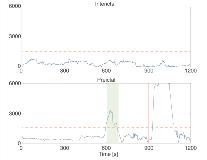Heart Rate Variability Analysis-Based Epileptic Seizure Prediction Using Neural Network
Abstract number :
1.090
Submission category :
2. Translational Research / 2B. Devices, Technologies, Stem Cells
Year :
2018
Submission ID :
501379
Source :
www.aesnet.org
Presentation date :
12/1/2018 6:00:00 PM
Published date :
Nov 5, 2018, 18:00 PM
Authors :
Koichi Fujiwara, Kyoto University; Fumiya Sakane, Kyoto University; Miho Miyajima, Tokyo Medical and Dental University; Toshitaka Yamakawa, Kumamoto University; Manabu Kano, Kyoto University; and Taketoshi Maehara, Graduate School of Medical and Dental Sc
Rationale: Epileptic seizure prediction has been attempted by combining heart rate variability (HRV) analysis and machine learning techniques based on the hypothesis that ictal discharge around seizures affects HRV. An anomaly detection algorithm is appropriate for seizure prediction. Although the interictal data and the preictal data are defined as normal data and anomalous data in seizure prediction, it is difficult to collect a sufficient number of preictal data from epileptic patients and collecting the interictal data is much easier than preictal data collection. In general, both normal and anomalous data are needed for modeling; however, anomaly detection requires only normal data. Fujiwara et al. (2016) developed an epileptic seizure prediction algorithm based on multivariate statistical process control (MSPC), which is a well-known anomaly detection methodology used in process control. Since MSPC is based on principal component analysis (PCA) that finds linear combinations of variables that describe major trends in a dataset, MSPC detects a sample that does not follow the major trend in the modeling data as an anomaly. However, PCA cannot model a nonlinear relationship between variables, and HRV is nonlinear physiological phenomenon. The present work proposes a new HRV-based epileptic seizure prediction algorithm that can consider nonlinearity using neural network (NN). Methods: This work uses autoencorder (AE) for anomaly detection from HRV data of epileptic patients, which is a kind of NN for data compressing and feature extraction. Eight HRV features, Mean NN, RMSSD, SDNN, NN50, Total Power, LF, HF and LF/HF, are adopted as input. When the norm of reconstruction errors of eight HRV features by AE exceed the predefined control limit for more than ten seconds, a seizure is predicted. Fig. 1 shows a structure of AE used for seizure prediction. The activation function in the hidden layer is the sigmoid function.The clinical data of patients with refractory epilepsy were collected from patients admitted to the Tokyo Medical and Dental University (TMDU) hospital, the National Center of Neurology and Psychiatry (NCNP) hospital, and the Tohoku University Hospital (TUH) for clinical video-EEG monitoring. These data collection and analysis were approved by the Medical Research Ethics Committee of TMDU, NCNP, and TUH. The clinical data were collected from 14 epileptic patients with localization-related epilepsy, and the numbers of collected interictal and preictal episodes were 64 and 15, and their lengths were 58 h and 11 h, respectively. The AE model was trained from 24 interictal episodes and all preictal episodes and all interictal episodes that were not used for training were used for validation. Results: Application results of AE-based seizure prediction are shown in Fig. 2. Horizontal dashed and vertical lines express the control limit and the seizure onset, respectively. A colored band denotes a preictal period discriminated by the proposed method. This result shows that the seizure was predicted prior its onset successfully. Seizure were predicted in 12 out of 15 interictal episodes, and the false positive (FP) rate was 0.7 times/h. This FP rate was higher than the Fujiwara’s algorithm whose FP rate was 1.5 times/h while the seizure prediction performance did not change. It is concluded that the proposed algorithm can suppress FPs. Conclusions: This work proposed a new HRV-based seizure prediction algorithm by using NN. Its application result to the clinical data demonstrated that the proposed method reduced FPs in comparison with the conventional method. Funding: JSPS KAKENHI Grant Number JP25282175; AMED SENTAN 171122; the Hattori Hokokai Foundation; the SECOM Science and Technology Foundation; the Murata Science Foundation
